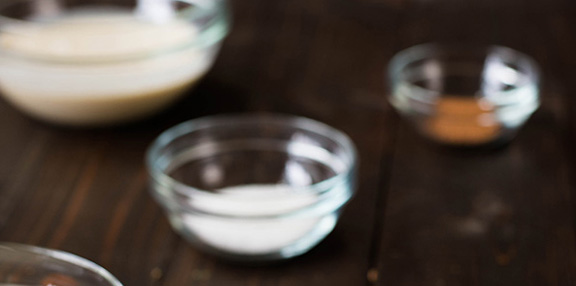
December 15, 2016
A Phrasal Template
Being given only the most basic framework of ingredients and directions in a recipe can be liberating in its imperfectly perfect way. (Think Mark Bittman over Thomas Keller.) Egg nog falls into this category. It doesn’t require technique or advance preparation, and for the most part, much time. Making the concoction of warmed dairy, eggs, sugar, spices and readily available alcohol a delicious act of improvisation.
EGG NOG
Throughout history egg nog has been imbibed, around the world, at all times of the year—not just during the winter holidays. Though it originated in Europe around the 13th century, egg nog became popular in North America in the 18th century. The first president of the United States, George Washington, was quite a fan, and devised his own recipe that included rye whiskey, rum and sherry. It was reputed to be a stiff drink that only the most courageous were willing to try:
One quart cream, one quart milk, one dozen tablespoons sugar, one pint brandy, 1/2 pint rye whiskey, 1/2 pint Jamaica rum, 1/4 pint sherry—mix liquor first, then separate yolks and whites of eggs, add sugar to beaten yolks, mix well. Add milk and cream, slowly beating. Beat whites of eggs until stiff and fold slowly into mixture. Let set in cool place for several days. Taste frequently.
While running for President in 1840, William Henry Harrison became known — in a positive way — for his drinking habits, which ran to hard cider, but egg nog was Harrison’s favorite drink. Egg nog is generally believed to be a descendant of posset, a sugar-and-spice, hot milk punch curdled with wine or beer. Popular during Medieval times, especially among the nobility and upper class (in the absence of refrigeration only wealthy estates had access to fresh milk), warm posset was administered to those suffering from insomnia and minor illnesses, particularly the common cold. Considering Harrison dropped dead after just a month in office, the drink’s medicinal properties are probably mild.
In 1845 General T.J. Green wrote a memoir¹ on his expedition—and subsequent imprisonment—to fight the Mexicans during the Texas Revolution. In it he speaks of shrewdly convincing his jailers into smuggling in ingredients for rompope (mescal, piloncillo, hen eggs and donkey’s milk) so he and his men could celebrate San Jacinto Day.
We’ve adapted a portion of Green’s retelling, and assembled a phrasal template found on the front of this year’s Holiday Card. You might know of phrasal templates from Mad Libs, the word game where one player prompts others for a list of words to substitute for blanks in a story, before reading the – often comical or nonsensical – story aloud. We invite you to partner up with someone and give the tale of egg nog a go. THEN reveal Green’s actual text, here.
May 2017 be a year where your words delight, carry influence and inspire connection.
Jennifer & David
____________________________________
¹ Gen. Thomas J. Green, 1845, Journal Of The Texian Expedition Against Mier: Subsequent Imprisonment Of The Author; His Sufferings And Final Escape From The Castle Perote.
Photo: Lacey Baier / A Sweet Pea Chef